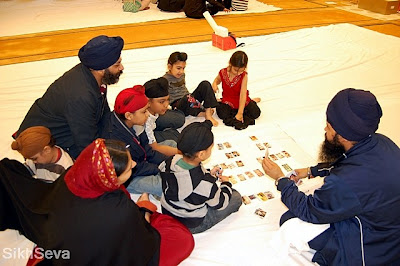On Sunday 5th October, Hounslow Singh Sabha Gurdwara along with the help of Sikh Seva group organized a one-day Sikhi camp, open to all ages. It was first of a kind event held at the Gurdwara Sahib. The amount of Sangat and children grew as the day went on, which was very good to see.
The camp started at 10am with Ardaas, Hukamnama, and vichaar (discussion) on the message of the Hukamnama. After doing some Simran, Bhaji Vijay Singh did a short talk on the basics of Sikhi. This was followed by a group work activity based on learning about the history of the Ten Gurus. Groups had to discuss image cards which depicted different Saakhis from the Ten Gurus lives. The story cards had to be matched with the correct Guru Sahib and the group had to discuss the history and message behind the Saakhi. The activity was concluded by going through some of the answers and stressing the need of learning one's history and how we can do this.
After lunch, the younger children watched a Sikhi film and the elders did a workshop discussion looking at issues affecting young Sikhs at school, college and university. This was followed by a Q&A session which went through questions that campers had put in a Q&A box throughout the day. The day ended with the Sangat doing Simran, followed by Ardaas & Hukamnama.
Some photos below (taken from Ravjeet Singh's flickr):

Satguru Sri Guru Granth Sahib jee (beautiful palki!).

Bhenji Amrit Kaur's group.

Bhaji Vijay Singh's group.

Saakhi (story) cards arranged to match the correct Guru Sahib the Saakhi is linked to.

Daas's group.

Veer Jagdeep Singh with younger children.

Bhaji Mandeep Singh working with a younger group.

Exhibition celeberating 300 years of Sri Guru Granth Sahib jee.

Display board showing the different concepts, themes, and topics covered in Sri Guru Granth Sahib jee.

Display boards showing a timeline of Sikh history.

Younger children watching Sikhi film.

Question & Answers session with elder group


Q&A session

Satguru Sri Guru Granth Sahib jee.
More photos on flickr.
Dhan Guru, Dhan Hai Teree Sikhee.
The camp started at 10am with Ardaas, Hukamnama, and vichaar (discussion) on the message of the Hukamnama. After doing some Simran, Bhaji Vijay Singh did a short talk on the basics of Sikhi. This was followed by a group work activity based on learning about the history of the Ten Gurus. Groups had to discuss image cards which depicted different Saakhis from the Ten Gurus lives. The story cards had to be matched with the correct Guru Sahib and the group had to discuss the history and message behind the Saakhi. The activity was concluded by going through some of the answers and stressing the need of learning one's history and how we can do this.
After lunch, the younger children watched a Sikhi film and the elders did a workshop discussion looking at issues affecting young Sikhs at school, college and university. This was followed by a Q&A session which went through questions that campers had put in a Q&A box throughout the day. The day ended with the Sangat doing Simran, followed by Ardaas & Hukamnama.
Some photos below (taken from Ravjeet Singh's flickr):

Satguru Sri Guru Granth Sahib jee (beautiful palki!).

Bhenji Amrit Kaur's group.

Bhaji Vijay Singh's group.

Saakhi (story) cards arranged to match the correct Guru Sahib the Saakhi is linked to.

Daas's group.

Veer Jagdeep Singh with younger children.

Bhaji Mandeep Singh working with a younger group.

Exhibition celeberating 300 years of Sri Guru Granth Sahib jee.

Display board showing the different concepts, themes, and topics covered in Sri Guru Granth Sahib jee.

Display boards showing a timeline of Sikh history.

Younger children watching Sikhi film.

Question & Answers session with elder group


Q&A session

Satguru Sri Guru Granth Sahib jee.
More photos on flickr.
Dhan Guru, Dhan Hai Teree Sikhee.














































